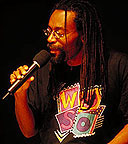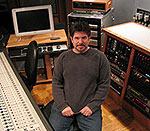 |
| Bobby McFerrin |
For this tip, I interviewed Dan Vicari, FOH and monitor mixer for
artist Bobby McFerrin. In addition to mixing McFerrin shows, Vicari
owns and operates LAFX Studios and LAFX equipment rentals in North
Hollywood, CA. McFerrin's shows range from amazing,
one-man performances all the way to big stage productions
with full band and other singers.
Vicari states: "Fifteen
years ago, when I first started working with Bobby, a couple
of problems were clear to me. One was the difficulty in getting
enough clear low-end on his vocal for the simultaneous bass
lines he does while singing. Getting that to sound clear and
not washy was complicated by all the different venues we worked
in where either the low end, centered on 160 Hz, would boom
or problems in the lower midrange, around the 300 Hz to 400
Hz region would pop up.
“My other problem was finding a good equalizer setting that
worked well when Bobby worked close (lips touching) to his wireless
handheld mic and also when he held the mic at chest height. I could EQ for
when he was close to the mic but when he backed off, it would thin
out. At that time, we didn't have the tools we have now so mixing
was always a two-fisted deal: one hand on the fader and the other
on the EQ."
And Now The Gear…
Besides his own vocal mics and wireless system, Vicari's two main
tools he carries are a BSS
DPR 901-II Four-Band Dynamic Equalizer and a dbx
120A Sub Harmonic Synthesizer.
"The DPR 901 isn't a 'new toy' but it has become an essential
problem solver for me. At soundcheck, I set up my EQ for good sound
at medium mic distance and then I put one of the DPR's bands (there
are four) in full expansion mode where, at a selected frequency,
the total system gain increases with more level of that frequency
band. I will, or I'll have someone talk loud and close into the
mic while I sweep frequencies at the narrowest Q to see where the
room takes off and explodes," he explains.
 When the trouble spots are located, Vicari changes the unit over
to full compression mode and adjusts the “Threshold”
and “Bandwidth” controls to take care of the problem
without sounding too drastic. Normally, those frequencies are reduced
as much as 6 to 8dB when McFerrin gets closer to the mic but since
it is dynamically changing, it never sounds bad.
This takes care of the room problems, as well as buildup with close
singing, but the real trick is to split the mic out to two console
fader inputs.
When the trouble spots are located, Vicari changes the unit over
to full compression mode and adjusts the “Threshold”
and “Bandwidth” controls to take care of the problem
without sounding too drastic. Normally, those frequencies are reduced
as much as 6 to 8dB when McFerrin gets closer to the mic but since
it is dynamically changing, it never sounds bad.
This takes care of the room problems, as well as buildup with close
singing, but the real trick is to split the mic out to two console
fader inputs.
 |
| Dan Vicari |
"Because I mix monitors
from FOH, I'll have the DPR processed fader going to the house
and the second fader going to his monitors without any processing
or effects. Sometimes I'll bring that second fader into the
house mix when I need a little more unaffected or direct sound."
Both fader channels are compressed usually with a dbx limiter/compressor
or tube compressors if the local sound company has them,”
he notes.
The dbx 120A comes into play as another dynamic equalizer—it
adds sub only when there are low frequencies already present. Vicari
explains: "I've tried an H3000 harmonizer to get that lower
octave but it effected Bobby's whole vocal range—not good.
“On the other hand, the 120A beefs up the low end only on
Bobby's bass lines. Besides, I only use this subtly, like a light
EQ and NOT for a big, noticeable effect. I set the 120A in the middle
of its range and bring its return up on a fader and blend it in
the house mix but not in the monitors. Again the amount of the sub
harmonic depends on the particular house we're working in but I
find that this lower octave is below the usual problem area so it
works out great for a fat sound at all times."